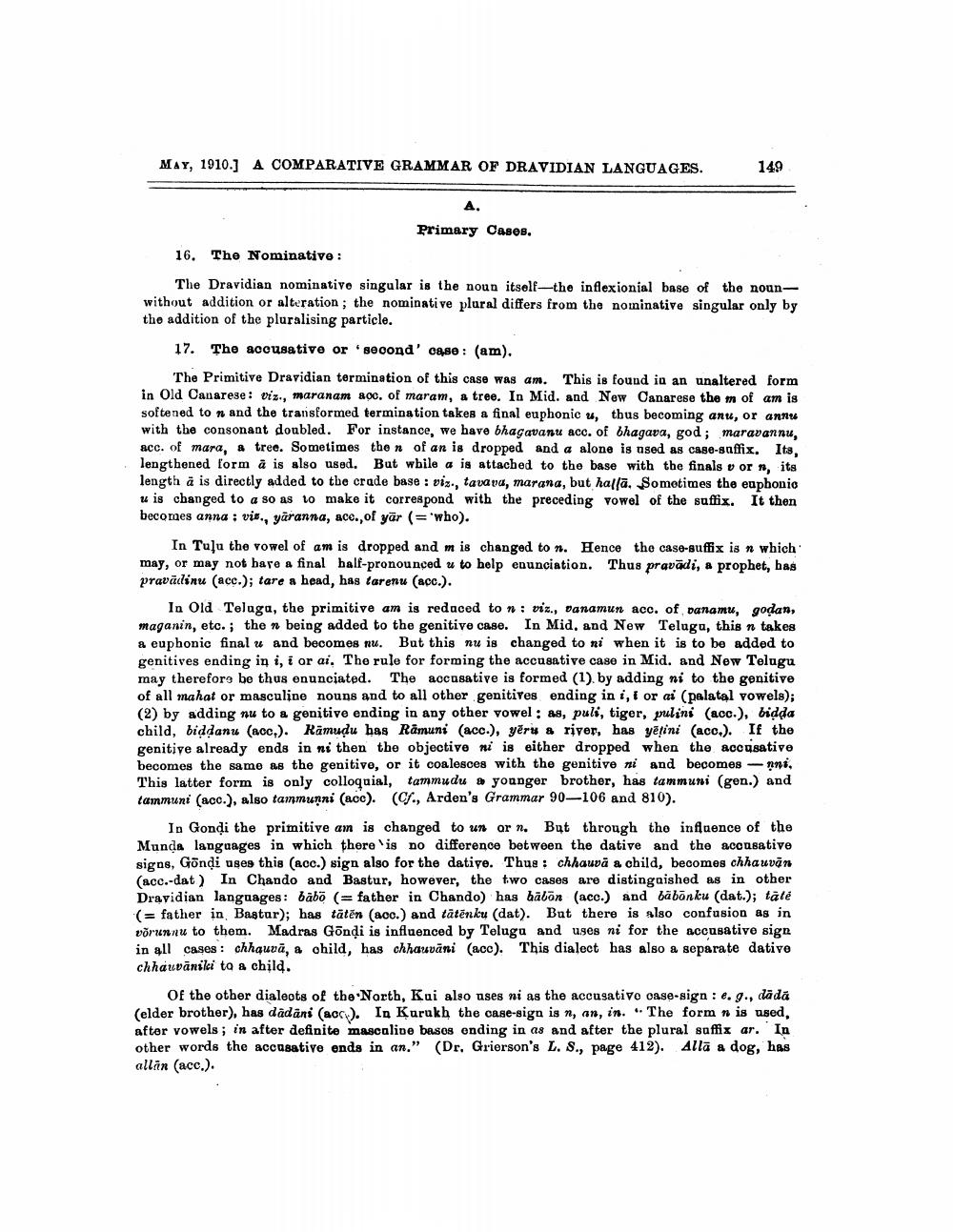________________
MAY, 1910.] A COMPARATIVE GRAMMAR OF DRAVIDIAN LANGUAGES.
A.
Primary Cases.
149
16. The Nominative :
The Dravidian nominative singular is the noun itself the inflexionial base of the nounwithout addition or alteration; the nominative plural differs from the nominative singular only by the addition of the pluralising particle.
17. The accusative or second' case: (am).
The Primitive Dravidian termination of this case was am. This is found in an unaltered form in Old Canarese: viz., maranam aoc. of maram, a tree. In Mid. and New Canarese the m of am is softened to n and the transformed termination takes a final euphonic u, thus becoming anu, or annu with the consonant doubled. For instance, we have bhagavanu acc. of bhagava, god; maravannu, acc. of mara, a tree. Sometimes the n of an is dropped and a alone is used as case-suffix. Its, lengthened form a is also used. But while a is attached to the base with the finals vorn, its length a is directly added to the crade base: viz., tavava, marana, but halla. Sometimes the euphonic u is changed to a so as to make it correspond with the preceding vowel of the suffix. It then becomes anna vis., yaranna, acc., of yar (= 'who).
In Tulu the vowel of am is dropped and m is changed to n. Hence the case-suffix is n which may, or may not have a final half-pronounced u to help enunciation. Thus pravādi, a prophet, has pravādinu (acc.); tare a head, has tarenu (acc.).
In Old Teluga, the primitive am is reduced to n: viz., vanamun acc. of vanamu, godan, maganin, etc.; then being added to the genitive case. In Mid. and New Telugu, this n takes a euphonic final u and becomes nu. But this nu is changed to ni when it is to be added to genitives ending in i, i or ai. The rule for forming the accusative case in Mid. and New Telugu may therefore be thus enunciated. The accusative is formed (1). by adding ni to the genitive of all mahat or masculine nouns and to all other genitives ending in i, i or ai (palatal vowels); (2) by adding nu to a genitive ending in any other vowel: as, puli, tiger, pulini (acc.), bidda child, biddanu (acc,). Rāmuḍu has Ramuni (acc.), yēru a river, has yetini (acc.). If the genitive already ends in ni then the objective ni is either dropped when the accusative becomes the same as the genitive, or it coalesces with the genitive ni and becomes-nni, This latter form is only colloquial, tammudu a younger brother, has tammuni (gen.) and tammuni (acc.), also tammunni (acc). (Cf., Arden's Grammar 90-106 and 810).
In Gondi the primitive am is changed to un or n. But through the influence of the Munda languages in which there is no difference between the dative and the accusative signs, Gōndi uses this (acc.) sign also for the dative. Thus: chhauva a child, becomes chhauvan (acc.-dat) In Chando and Bastur, however, the two cases are distinguished as in other Dravidian languages: babo (= father in Chando) has babon (acc.) and babōnku (dat.); taté (= father in Bastur); has täten (acc.) and tätěnku (dat). But there is also confusion as in võrunnu to them. Madras Gōndi is influenced by Telugu and uses ni for the accusative sign in all cases: chhauva, a child, has chhauvani (acc). This dialect has also a separate dative chhauvāniki to a child.
Of the other dialects of the North, Kui also uses ni as the accusative case-sign: e. g., dādā (elder brother), has dadāni (acc). In Kurukh the case-sign is n, an, in. The form n is used, after vowels; in after definite mascaline bases ending in as and after the plural suffix ar. In other words the accusative ends in an." (Dr. Grierson's L. S., page 412). Alla a dog, has
allan (acc.).




